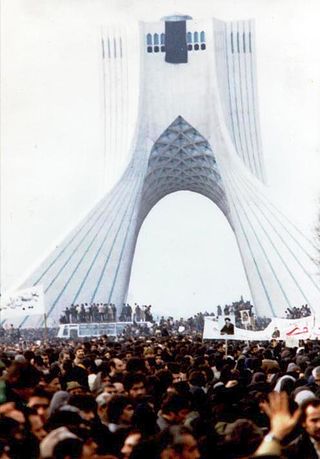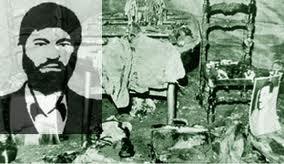
Sayyed Mohammad Hosseini Beheshti was an Iranian jurist, philosopher, cleric and politician who was known as the second person in the political hierarchy of Iran after the Revolution. Beheshti is considered to have been the primary architect of Iran's post-revolution constitution, as well as the administrative structure of the Islamic republic. Beheshti is also known to have selected and trained several prominent politicians in the Islamic Republic, such as former presidents Hassan Rouhani and Mohammad Khatami, Ali Akbar Velayati, Mohammad Javad Larijani, Ali Fallahian, and Mostafa Pourmohammadi. Beheshti also served as the Secretary General of the Islamic Republic Party, and was the head of the Iranian judicial system. He further served as Chairman of the Council of Islamic Revolution, and the Assembly of Experts. Beheshti earned a PhD in philosophy, and was fluent in English, German and Arabic.

Mohammad-Ali Rajai was an Iranian politician who served as the second president of Iran from 2 August 1981 until his assassination four weeks later. Before his presidency, Rajai had served as prime minister under Abolhassan Banisadr, while concurrently occupying the position of foreign affairs minister from 11 March 1981 to 15 August 1981. He died in a bombing on 30 August 1981 along with then-prime minister Mohammad-Javad Bahonar.

Mohammad-Reza Bahonar is an Iranian principlist politician who was member of the Parliament of Iran for 28 years. He is also secretary general of Islamic Society of Engineers and the Front of Followers of the Line of the Imam and the Leader. He is currently member of the Expediency Discernment Council.

Mohammad-Javad Bahonar was a Shia Iranian theologian and politician who served as the Prime Minister of Iran for less than one month in August 1981. Bahonar and other members of Mohammad-Ali Rajai's government were assassinated by Mujahideen-e Khalq.

The prime minister of Iran was a political post that had existed in Iran (Persia) during much of the 20th century. It began in 1906 during the Qajar dynasty and into the start of the Pahlavi dynasty in 1923 and into the 1979 Iranian Revolution before being abolished in 1989.

The interim government of the Islamic Republic of Iran was established after the assassination of Mohammad-Ali Rajai (President) and Mohammad Javad Bahonar on 30 August. In accordance with the constitution, a Provisional Presidential Council formed the same day and proposed Mohammad-Reza Mahdavi Kani as prime minister to the Majlis. Majlis voted in favour of him on 2 September. His cabinet also received approval of the Majlis on 3 September. The main responsibility of this government was holding presidential elections. On 13 October, Ali Khamenei officially became president. His prime minister, Mir-Hossein Mousavi received Majlis's approval on 29 October and then the new government replaced Mahdavi-Kani's interim government.
Presidential elections were held in Iran on 24 July 1981 after the previous Iranian president, Abolhassan Banisadr, was impeached by the Majlis on 21 June and then sacked by the Supreme Leader, Ayatollah Khomeini, on 22 June. The elections occurred after the Hafte Tir bombing, which killed Mohammad Beheshti and dozens of other Iranian officials on 28 June 1981. This led to the election of Mohammad Ali Rajai, the previous prime minister, winning 13,001,761 votes out of the 14,573,803 votes cast, which was 89% of the votes. The vote turnout was 65.29%.

Ayatollah Mohammad Reza Mahdavi Kani was an Iranian Shia cleric, writer and conservative and principlist politician who was Prime Minister of Iran from 2 September until 29 October 1981. Before that, he was Minister of Interior in the cabinets of Mohammad-Ali Rajai and Mohammad-Javad Bahonar. He was the leader of Combatant Clergy Association and Chairman of the Assembly of Experts and also founder and president of Imam Sadiq University.
Numerous civilians, including men, women, children, government officials, activists, secular intellectuals and clerics have been victims of assassination, terrorism, or violence against non-combatants, over the course of modern Iranian history. Among the most notable acts of terrorism in Iran in the 20th century have been the 1978 Cinema Rex fire and the 1990s chain murders of Iran.

This article is a timeline of events relevant to the Islamic Revolution in Iran. For earlier events refer to Pahlavi dynasty and for later ones refer to History of the Islamic Republic of Iran. This article doesn't include the reasons of the events and further information is available in Islamic revolution of Iran.

The Cabinet of Iran is a formal body composed of government officials, ministers, chosen and led by the President of Iran. Its composition must be approved by a vote in parliament. According to the Constitution of the Islamic Republic of Iran, a president may dismiss members of the cabinet, but must do so in writing, and new appointees must again be approved by parliament. The cabinet meets weekly on Saturdays in Tehran. There may be additional meetings as circumstances require. The president chairs them. The Supreme Leader of Iran Ali Khamenei has the power to dismiss cabinet members like ministers, vice presidents and presidents at any time, regardless of parliamentary decisions.(citation needed)
Premiership of Mir-Hossein Mousavi were the third and fourth government of Iran after the Iranian Revolution. At that time, Ali Khamenei was the president.

In August 1981, President Mohammad-Ali Rajai and Prime Minister Mohammad-Javad Bahonar were assassinated in an explosion. Ali Khamenei was then elected as the third president of Iran in the October 1981 Iranian presidential election. He put forward Ali Akbar Velayati as his prime minister, but the Iranian parliament did not give him the vote of confidence, and he was defeated with a vote of 80 to 74. Subsequently, Ali Khamenei, though he had strong disagreements with Mousavi, as a compromise with the left-leaning parliament, agreed to offer him, Mousavi, for the post of premier. On 28 October, the parliament approved Mousavi with a vote of 115 to 39. Mousavi became the 79th Prime Minister of Iran on 31 October 1981, and remained the prime minister of Iran until 3 August 1989, for eight years.

The Government of Mohammad-Ali Rajai was the first government of Iran after the Iranian Revolution. At that time, Abolhassan Banisadr was president and Mohammad-Ali Rajai was prime minister.
Shahid Bahonar may refer to the following, named after Iranian prime minister Mohammad-Javad Bahonar assassinated in the 1981 Iranian Prime Minister's office bombing:

Sayyid Mahmoud Kashani is an Iranian politician, academic, writer and lawyer. He is also a professor in Shahid Beheshti University. He was head of the Iranian delegation to the International Court of Justice in The Hague, Netherlands from 1981 to 1985. He was also a presidential candidate in the 1985 and 2001 elections.

The following lists events that happened during 1981 in Iran.

The office of Mohammad Javad Bahonar, Prime Minister of Iran, was bombed on 30 August 1981 by the People's Mujahedin of Iran (MEK), killing Prime Minister Bahonar, President Mohammad Ali Rajai, and six other Iranian government officials. The briefcase bombing came two months after the Hafte Tir bombing, which killed over seventy senior Iranian officials, including Chief Justice Mohammad Beheshti, then Iran's second-highest official. It is also reported that the director general of the prime minister's administration and an elderly woman bystander outside the building were killed.

Masoud Keshmiri was an Iranian militant who was the member of the People's Mujahedin of Iran (MEK) who infiltrated the Islamic Republican Party (IRP) and came up through the ranks, reaching the position of secretary of the Supreme National Security Council, before planting an incendiary bomb in his briefcase that blew up the Prime Minister's office in 1981. Victims of the explosion were President Mohammad-Ali Rajai and Prime Minister Mohammad-Javad Bahonar among others.












